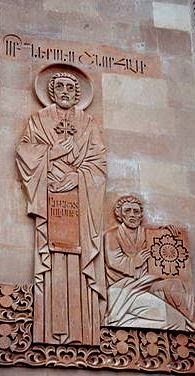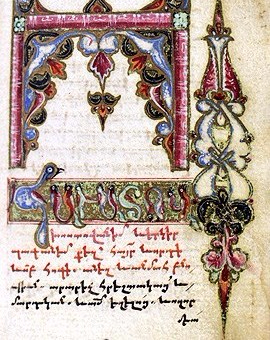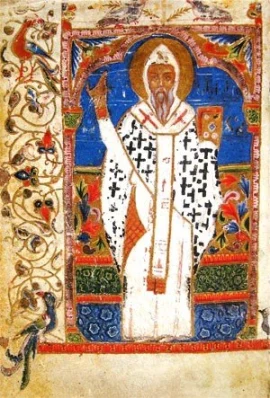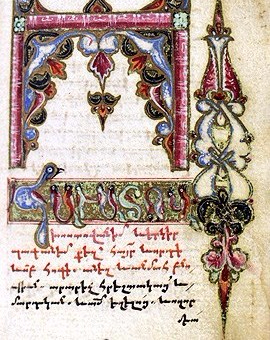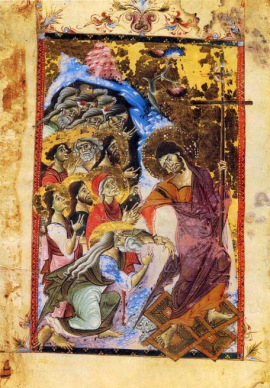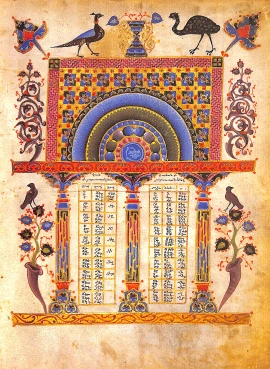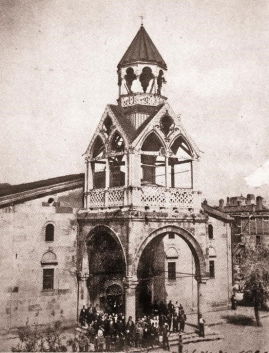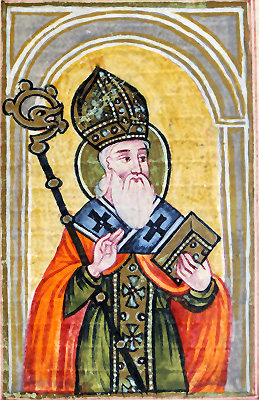.
“I Confess with Faith”
“Havadov Khosdovanim”
St. Nerses IV Shnorhali – the Gracious (1102 – 1173)
.
.
Havadov Khosdovanim by St. Nerses Shnorhali, 1st page from 13th century Armenian illuminated manuscript
.
.
.
.
.
 “I Confess with Faith”
“I Confess with Faith”
ՀԱՎԱՏՈՎ ԽՈՍՏՈՎԱՆԻՄ
Saint Nerses IV Shnorhali – Ս. Ներսէս Շնորհալի
.
.
.
.
.
 Collection of translations
Collection of translations
“I Confess with Faith” ՀԱՎԱՏՈՎ ԽՈՍՏՈՎԱՆԻՄ
.
.
.
.
.
 Armenian Illuminated Manuscripts
Armenian Illuminated Manuscripts
unique pieces of Armenian religious art through the centuries
.
.
.
.
.
 “Khoran” Illuminated Canon Tables
“Khoran” Illuminated Canon Tables
their meaning, role and significance for the Armenian Church
.
.
.
.
.
 Our Cultural Heritage
Our Cultural Heritage
Churches of Historic Armenia
Landmarks of the lost heritage of the Armenian Church
.
.
.
.
.
.
.
St. Nerses Shnorhali – the Gracious (1102-1173)
Սուրբ Ներսէս Շնորհալի
.
.
Saint Nerses IV the Gracious, Catholicos of Cilicia, (in Armenian: “Sourp Nerses Shnorhali” – Սուրբ Ներսէս Դ. Կլայեցի Շնորհալի, in Greek: Άγιος Νερσές ο γεμάτος χάρη Θεού, in Russian: Св. Нерсес IV Шнорали – Клаеци “Благодатный”), is a major theologian, poet, writer and hymn composer of the Armenian Church. He is considered one of the greatest literary figures in the Armenian ecclesiastical history.
Nerses was born in June 4, 1102 in Tsopk castle near Aintab (present-day Gaziantep, Turkey). He was descendant of the noble Pahlavouni family, and through female lineage he was descendant of St. Gregory the Illuminator. His father Apirat Pahlavouni was an army general, who was killed in a battle at the time Nerses was only ten years old.
After the early loss of their father, Nerses and his older brother Gregory were placed under the guardianship of their maternal grand uncle Catholicos Gregory II the Martyrophile (Գրիգոր Բ. Վկայասէր). They were settled in “Karmir Vank” (“Կարմիր Վանք”) an Armenian monastery at Fhoughri, under the custody of monk Stepanos Manouk, a renowned scholar and theologian.
Nerses was ordained as a celibate priest at the age of 17. He was consecrated as a bishop at the age of 35. In 1112, his older brother became Catholicos Gregory III Pahlavouni (Գրիգոր Գ. Պահլաւունի). In 1116, the Catholicosate of Armenia moved from Dzamentav (Zamidia, present day Zamanti) to Dzovk (present day Gölcük). In 1149, the Catholicosate moved to Hromkla (present day Rumkale) near river Euphrates.
The fall of the Armenian Kingdom of the Bagratunis in 1045 and the destruction of the capital Ani by the Seljukid Turks in 1064, had forced the Holy See of the Armenian Church to search for a new settlement. After several changes of place, in 1149 the See has been settled in the fortress of Hromkla (Hrom-Kla: Roman Fortress), present day Rumkale, on the banks of the Euphrates River, very close to the border of the Armenian Kingdom of Cilicia.
In Hromkla, soon after the death of his brother in 1166, Nerses became Catholicos Nerses IV. As a bishop and later as Catholicos, Nerses strongly supported the efforts for reconciliation between the Churches. In 1141, Nerses attended as observer the Council of Antioch, a Council of the Catholic Church held during the Crusaders’ occupation of the Levant.
In 1166, Nerses wrote a profession of faith, known as “Exposition of the Faith of the Armenian Church” addressed to the Byzantine emperor Manuel I Comnenos (1166-1180). In his exposition, Nerses referred to the relations between the Armenian and Greek Churches, emphasizing the fact that since both Churches had accepted the statements of the First Ecumenical Council of Ephesus, there was no reason not to reach in an agreement.
In 1171, the emperor and the Orthodox Patriarch Michael III addressed an official letter of reconciliation to the Armenian Church. A delegation was sent from Constantinople, and both sides laid the groundwork for the start of an ecumenical dialogue. However, this dialogue ultimately bore no fruit. After the death of emperor Manuel I, the subsequent political events in the Byzantine empire made its continuation impossible.
Nerses for the rest of his life never ceased to support the approach and the reconciliation between the Churches. At the age of 70, following the tradition of his family, he named as his successor the younger of his two nephews (both of them were bishops). The elder, however, imprisoned his cousin and had himself consecrated Catholicos under the name Gregory IV (Գրիգոր Դ. Տղայ). Nerses reposed himself in August 13, 1173 worn out by ceaseless work and malaria.
Nerses IV has been canonized as a Saint by the Armenian Apostolic Church. He has received the title of “Gracious” (in Armenian: Shonrhali “Շնորհալի”) because of his irenic style and quality of writing. His radiating holiness, which made his contemporaries say that he was “filled with the graces of the Holy Spirit, like a sea that is spread everywhere”. His writings are full of serenity and divine grace. He is recongnized as the “Second Illuminator” of the Armenians. Along with his nephew, St. Nerses of Lampron, the archibishop of Tarsus (Սուրբ Ներսես Լամբրոնացի 1153-1198), are both considered the ardent artisans and champions of the Church unity.
St. Nerses’ feast is celebrated by the Armenian Apostolic Church in mid-October, on the Saturday of the Fourth Week of the Holy Cross. He is also venerated by the Roman Catholic Church. His feast is celebrated on August 13th.
St. Nerses was a prolific writer, a great musician, as well as one of the greatest theologians of his time. He composed prayers, liturgical songs, and chants. He wrote several volumes of poetry, and a vast number of theological works. St. Nerses enriched the Armenian liturgical hymnology with a wealth of sacred hymns, adding almost a third to their number. He is credited with musical reforms that simplified the texts of the religious poetry and the melodies of the chant, bringing it closer to the style of Armenian folk music.
His major poetic works include “Aravot Louso” (“Առաւոտ լուսոյ”: Morning of Light) a collection of prayers for the sunrise service vespers, “Norahrash Bsagavor” (“Նորահրաշ Պսակաւոր”: Newly and Marvelously Crowned) a festive liturgical hymn, “Vipasanoutyoun” (“Վիպասանութիւն”: Enlightenment) a novel in poetic form, and “Voghb Yedesyo” (“Վողբ Էդեսիոյ”) a lamentation on the fall of Edessa in 1144 (the present-day Şanlıurfa).
“Toukht Enthanrakan” (“Թուխտ Ընթրանաքան”: General Epistle) is an exhortation of St. Nerses on pastoral theology and on how Christians should behave. “Hisous Vordi” (“Հիսուս Որդի”) is a reproduction of the Bible in poetic form. It contains stories from Church history, concluding to the events of the End Times. It has been translated into English as “Jesus the Son”.
“I Confess with Faith” is a literary collection of twenty-four prayers (in Armenian: Havadov Khosdovanim “Հաւատով խոստովանիմ”). A prayer for every hour of the day. It has been considered as one of his most prominent works, intended to provide comfort, peace and spiritual strength to the Christians. “Havadov Khosdovanim” has been translated into more than 36 languages. This unique prayer bears the faith, trust, and absolute hope of St. Nerses towards God.
.
.
.
.
St. Nerses IV Catholicos of Armenia – the Gracious, detail from manuscript
.
.
.
.
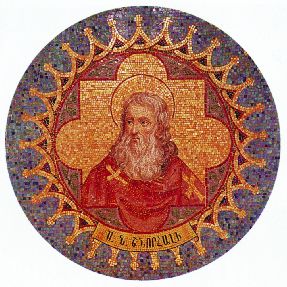
St. Nerses Shnorhali, detail from mosaic, Mekhitarists’ abbey, San Lazzaro, Venice
.
.
.
.
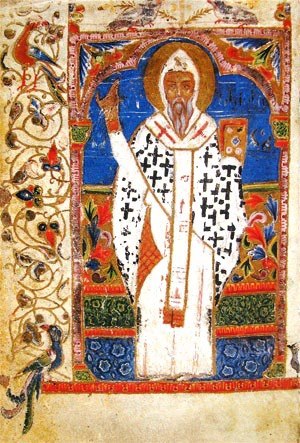
St. Nerses Shnorhali, illustration from Armenian illuminated manuscript
.
.
.
.
